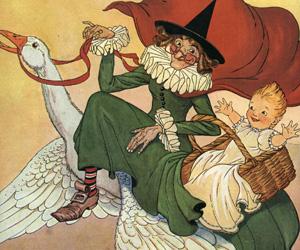Words of Wisdom from SharLeigh
THE LURE OF OLD MOTHER GOOSE
Many can repeat the Mother Goose nursery rhymes that have been around for centuries. Some of those ditties are still circulating through our brain – like London Bridge is Falling Down – Hey Diddle, Diddle – Jack and Jill – Mary Had a Little Lamb – and Hickory Dickory Dock, to name a few. For me, it takes me back to early memories of loved ones reading from that great colorful book full of fanciful words and pictures. I knew that Mother Goose truly existed and would fly through the air on her gander. No matter how many times I was read to from that book, I never tired of listening. There is some debate as to the origins of who first put Mother Goose to print. In 1650 a French poem originated the name Mother Goose – then in 1697 Charles Perrault published eight fairy tales and incorporated the name of Mother Goose. In 1765, Englishman John Newberry published a compilation of rhymes, which included Mother Goose, and switched the focus from fairy tales to nursery rhymes. A reprint of the publication appeared in America in 1786 by Isaiah Thomas. This reprint was so popular that Mother Goose became a symbol of American childhood. Mother Goose nursery rhymes continue to be popular to this day because they serve up both literacy and love, all in one sitting. These rhymes provide young children with an introduction to a delightful way of using speech patterns and memorization before they can read the written word. The love of the parent while reading to the child increases the child’s desire to read and perform for their parents. All of the above creates inroads to literacy at an early age, not to mention the morals and values that are expressed in many of the rhymes. Here is a verse that has stood the test of time. “A wise old owl sat in an oak, the more he heard, the less he spoke. The less he spoke, the more he heard, why aren’t we all, like that wise old bird?” That is still a very good question.
Copyright
© 2007 10-4 Magazine and Tenfourmagazine.com
PO Box 7377 Huntington Beach, CA, 92615 tel. (714) 378-9990 fax
(714) 962-8506

